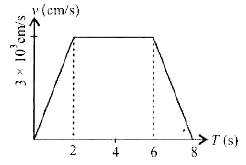Maximum Height|Questions|Cordinate Of A Particle After A Given Time T|Velocity And Direction Of Motion After A Given A Time
Step by step video solution for Maximum Height|Questions|Cordinate Of A Particle After A Given Time T|Velocity And Direction Of Motion After A Given A Time by Physics experts to help you in doubts & scoring excellent marks in Class 11 exams.
Updated on:21/07/2023Similar Questions
Coordinate Of A Particle After A Given Time t|Velocity And Direction Of Motion After A Given Time|Velocity And Direction Of Motion After At A Given Height|Questions|Equation Of Trajectory|Questions
View SolutionCoordinate Of A Particle After A Given Time t|Velocity And Direction Of Motion After A Given Time|Velocity And Direction Of Motion After At A Given Height|Questions|Equation Of Trajectory|Questions
View Solution
Knowledge Check
The velocity time graph of the motion of a car is given here.
 AThe distance travelled by the car in the first six seconds is 150 m.BThe deceleration of the car during the last two seconds are −15ms2.CThe distance travelled by the car in the first six second is 220 m.DThe deceleration of the car during the last two second is −20ms2
AThe distance travelled by the car in the first six seconds is 150 m.BThe deceleration of the car during the last two seconds are −15ms2.CThe distance travelled by the car in the first six second is 220 m.DThe deceleration of the car during the last two second is −20ms2A particle moves so that s=6+48t-t3. The direction of motion reverses after moving a distance of
A63B104C134D288
Coordinate Of A Particle After A Given Time t|Velocity And Direction Of Motion After A Given Time|Velocity And Direction Of Motion At Given Height|Exercise Questions|Equation Of Trajectory
View SolutionCoordinate Of A Particle After A Given Time t|Velocity And Direction Of Motion After A Given Time|Velocity And Direction Of Motion At Given Height|Exercise Questions|Equation Of Trajectory
View SolutionIf a particle is projected from O at an elevation α and after time t the particle is at P where the direction of motion is θ and OP is inclined to horizontal at β, then 2tanβ=tanα+tanθ.
View SolutionThe velocity time relation of a particle is given by v =(3t2−2t−1)m/s Calculate the position and acceleration of the particle when velocity of the particle is zero . Given the initial position of the particle is 5m .
View SolutionA particle moves with an initial velocity v0 and retardation alphav, where alpha is a constant and v is the velocity at any time t. If the particle is at the origin at t=0, find
(a) (i) velocity as a function of time t.
(ii) After how much time the particle stops?
(iii) After how much time velocity decreases by 50%?
(b) (i) Velocity as a function of displacement s.
(ii) The maximum distance covered by the particle.
(c ) Displacement as a function of time t.
View SolutionIf at any instant the velocity of a projectile be u and its direction of motion θ to the horizon then it will be moving at right angles to this direction, after time ugcosecθ
View Solution
